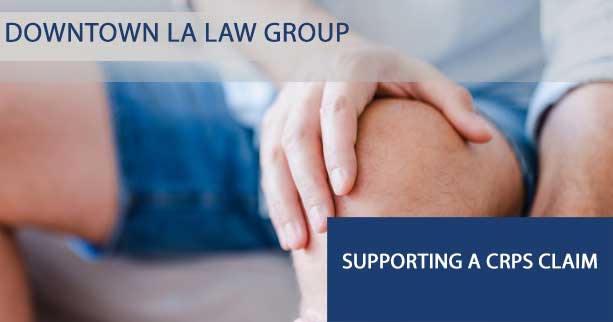Supporting a CRPS Claim
A client contacts you with severe and persistent pain that seems to have no resolution. At one point, there was clear trauma to the affected area; however, there is no longer a clear explanation behind the pain that your client is experiencing. Because these cases are generally very complicated, even experienced attorneys could struggle with these cases due to both conflicted medical evidence and the issue with finding the suitable damages and causation.
Although CRPS is a complicated matter, the claim does not have to be complicated. Attorneys must manage CRPS with more of a holistic approach – your client is dealing with chronic pain. The better that you understand that, the more likely the claim will lead to a successful outcome.
 CRPS – Complex Regional Pain Syndrome – is a type of chronic pain disorder that affects the extremities, such as the arms, legs, hands, or feet. There are two categories to CRPS – Type I and Type II. CRPS Type I is characterized specifically by swelling, pain, and vasomotor dysfunction of the affected extremity. What causes CRPS Type I? CRPS Type I is associated with a traumatic injury or a surgery; however, CRPS Type I is not associated with a nerve injury. On the other hand, CRPS Type II is directly associated with an injury to a nerve. What could lead to CRPS? Anything from a fracture, laceration, soft-tissue injury, or any sort of surgery has the potential to lead CRPS. In general, the typical pain associated with CRPS is described with sensations of pins and needles, electric shock, and burning, for example. CRPS has repeatedly been concluded to be one of the most painful pain disorders.
CRPS – Complex Regional Pain Syndrome – is a type of chronic pain disorder that affects the extremities, such as the arms, legs, hands, or feet. There are two categories to CRPS – Type I and Type II. CRPS Type I is characterized specifically by swelling, pain, and vasomotor dysfunction of the affected extremity. What causes CRPS Type I? CRPS Type I is associated with a traumatic injury or a surgery; however, CRPS Type I is not associated with a nerve injury. On the other hand, CRPS Type II is directly associated with an injury to a nerve. What could lead to CRPS? Anything from a fracture, laceration, soft-tissue injury, or any sort of surgery has the potential to lead CRPS. In general, the typical pain associated with CRPS is described with sensations of pins and needles, electric shock, and burning, for example. CRPS has repeatedly been concluded to be one of the most painful pain disorders.
 The Peripheral Nervous System can further be categorized into the autonomic nervous system and the somatic nervous system. The autonomic nervous system regulates all involuntary bodily process (such as heart rate, body temperature, digestion, and respiration) while the sympathetic nervous system prepares the body for any action or stress (fight or flight). What does this have to do with CRPS? CRPS is specifically a sympathetic pain disorder. In an individual, the sympathetic nervous system is activated under acute stress, resulting in pain. In an individual with CRPS, the sympathetic nervous system does not function correctly; instead, pain signals are constantly being sent out without a real reason. This results in constant pain.
The Peripheral Nervous System can further be categorized into the autonomic nervous system and the somatic nervous system. The autonomic nervous system regulates all involuntary bodily process (such as heart rate, body temperature, digestion, and respiration) while the sympathetic nervous system prepares the body for any action or stress (fight or flight). What does this have to do with CRPS? CRPS is specifically a sympathetic pain disorder. In an individual, the sympathetic nervous system is activated under acute stress, resulting in pain. In an individual with CRPS, the sympathetic nervous system does not function correctly; instead, pain signals are constantly being sent out without a real reason. This results in constant pain.
What is CRPS?
 CRPS – Complex Regional Pain Syndrome – is a type of chronic pain disorder that affects the extremities, such as the arms, legs, hands, or feet. There are two categories to CRPS – Type I and Type II. CRPS Type I is characterized specifically by swelling, pain, and vasomotor dysfunction of the affected extremity. What causes CRPS Type I? CRPS Type I is associated with a traumatic injury or a surgery; however, CRPS Type I is not associated with a nerve injury. On the other hand, CRPS Type II is directly associated with an injury to a nerve. What could lead to CRPS? Anything from a fracture, laceration, soft-tissue injury, or any sort of surgery has the potential to lead CRPS. In general, the typical pain associated with CRPS is described with sensations of pins and needles, electric shock, and burning, for example. CRPS has repeatedly been concluded to be one of the most painful pain disorders.
CRPS – Complex Regional Pain Syndrome – is a type of chronic pain disorder that affects the extremities, such as the arms, legs, hands, or feet. There are two categories to CRPS – Type I and Type II. CRPS Type I is characterized specifically by swelling, pain, and vasomotor dysfunction of the affected extremity. What causes CRPS Type I? CRPS Type I is associated with a traumatic injury or a surgery; however, CRPS Type I is not associated with a nerve injury. On the other hand, CRPS Type II is directly associated with an injury to a nerve. What could lead to CRPS? Anything from a fracture, laceration, soft-tissue injury, or any sort of surgery has the potential to lead CRPS. In general, the typical pain associated with CRPS is described with sensations of pins and needles, electric shock, and burning, for example. CRPS has repeatedly been concluded to be one of the most painful pain disorders.
– Attorney Discusses CRPS Workers Compensation Lawsuits
The Nervous System and CRPS
To understand CRPS, you must have a thorough understanding of the nervous system. There are two parts of the nervous system – the Central Nervous System and the Peripheral Nervous System. How are these two parts of the nervous system different? Ultimately, the Central Nervous System consists of the brain and the spinal cord, basically performing as the body’s control unit. On the other hand, the Peripheral Nervous System consists of the nerves that connect the Central Nervous System to every other part of the body. The Peripheral Nervous System can further be categorized into the autonomic nervous system and the somatic nervous system. The autonomic nervous system regulates all involuntary bodily process (such as heart rate, body temperature, digestion, and respiration) while the sympathetic nervous system prepares the body for any action or stress (fight or flight). What does this have to do with CRPS? CRPS is specifically a sympathetic pain disorder. In an individual, the sympathetic nervous system is activated under acute stress, resulting in pain. In an individual with CRPS, the sympathetic nervous system does not function correctly; instead, pain signals are constantly being sent out without a real reason. This results in constant pain.
The Peripheral Nervous System can further be categorized into the autonomic nervous system and the somatic nervous system. The autonomic nervous system regulates all involuntary bodily process (such as heart rate, body temperature, digestion, and respiration) while the sympathetic nervous system prepares the body for any action or stress (fight or flight). What does this have to do with CRPS? CRPS is specifically a sympathetic pain disorder. In an individual, the sympathetic nervous system is activated under acute stress, resulting in pain. In an individual with CRPS, the sympathetic nervous system does not function correctly; instead, pain signals are constantly being sent out without a real reason. This results in constant pain.
Diagnosis of CRPS
CRPS is not like other conditions. There is no specific test that can be used for a quick diagnosis of CRPS. Instead, a diagnosis is based on the specific symptoms and signs present in the individual. Diagnoses must be made using something called the Budapest criteria. The Budapest criterion consists of the following:– Can I Receive Workers Comp for PTSD
- Constant, continuous pain that is not correlated with any specific inciting occurrence
- At least one symptom in the following categories
- Sensory (hyoeraesthesia/allodynia)
- Vasomotor (temperature asymmetry, skin color asymmetry, skin color changes)
- Sudomotor/oedema (oedema, sweating changes, sweating asymmetry)
- Motor/trophic (tremor, weakness, trophic changes, dystonia)
- At least one sign in two or more of the following categories at the type of evaluation
- Sensory
- Vasomotor
- Sudomotor/oedema
- Motor/trophic
- There is no other better diagnosis available to explain the signs and symptoms
The Different Stages of CRPS
In general, CRPS conforms to three separate stages. Consider the following details:- Stage 1 CRPS. It typically lasts one to three months and includes many symptoms including but not limited to
- Burning or aching pain that is severe and worsens with even light touch/breeze
- Fluctuations between hot and cold in regards to skin temperature
- Rapid hair and nail growth
- Joint pain
- Muscle spasms
- Changes in skin texture, color, and appearance
- Increase in sweating
- Stage 2 CRPS. It can last anywhere from three to six months. During this time, the symptoms progress. The level of pain experienced increases significantly. The joints become stiff and the muscles become weak. The skin goes through more noticeable changes, and the nails become cracked and brittle.
- Stage 3 CRPS. CRPS that progresses to stage 3 will result in difficulty using the affected extremity. The muscles and tendons in the affected limb to atrophy (and contract); this could lead to clawing. It can become permanent.
Learn more about your legal options: call (855) 339-8879 to speak with a representative now.
Building the CRPS Case Objectively
Before you can build a CRPS case, you must be able to identify the case. In a CRPS case, all of the following must be present:- An injury that causes pain which is non-proportional to the injury
- Significant changes in both skin texture and color on the affected area
- An abnormal temperature or sweating pattern in the area
- Stiff joints in the affected area
- Problems with muscle movement coordination, including a decrease in the ability to move the affected body part
- Abnormal movement in the affected arm, hand, leg, or foot
– Complex Regional Pain Syndrome Attorney | CRPSAfter identifying the type of case, you can start focusing on building the case. In general, pain is subjective. However, CRPS comes paired with a number of objective factors, all of which can be used to build the case and essentially prove the diagnosis. These factors could include all of the following:
- Changes in motor function – including the loss of strength, a decrease in grip strength (relevant to hands), and difficulty standing on toes (relevant to feet). In general, there is some sort of limitation in the range of motion; it is possible that the affected limb has some sort of atrophy.
- Changes in skin temperature and color – including changes in skin color, skin temperature, edema, or sweat on the affected limb/extremity.
- Changes in hair and nails – including an increase in hair growth, an increase/decrease in nail growth, and a degree of skin atrophy only present in the affected limb or extremity.
Get started today by calling (855) 339-8879.
Because these changes only affect a specific limb/extremity, the affected limb/extremities can be directly compared to their unaffected counterparts – making it clear that there is an underlying issue. It is also essential that diagnosis is objective. As mentioned above, there are certain requirements that all signs/symptoms must fit for a diagnosis. In addition, there is no standard testing that can quickly lead to a diagnosis. Because CRPS affects patients in many different ways, it is also difficult to subject all patients to the same diagnosis method. Consider some of the following methods often used to objectively diagnose CRPS:- A bone scintigraphy (three-phases) to show abnormalities in the bone of the affected extremity or limb
- A measure of autonomic changes (sweat output, skin temperature, and reflex changes) taken over a time of at least five hours
- MRI to rule out other potential diagnosis (MRIs cannot determine CRPS)
Understanding CRPS Treatment
Unfortunately, CRPS is something that cannot be cured. However, the appropriate treatment can prevent the condition from progressing and can increase expected quality of life, for instance. Treatment options for CRPS include the following:- Pain management – this usually includes managing pain through both physical and occupational therapy options. Physical and occupational therapy can be beneficial in improving functional strength of the affected limb/extremity as well as in providing edema control strategies. In many cases, however, pain management attempts in the form of both physical and occupational therapy can become intolerable or even ineffective in the long-term due to the extent of the CRPS.
- Prescription medication – this usually includes the administration of a number of prescription medication, which is the primary treatment method for CRPS. Common prescriptions include both opiods and non-steroid anti-inflammatories. Gabapentin and Amitriptylilne, for example, which are usually used to treat seizures or depression, have been shown to be effective in addressing the neuropathic pain caused by CRPS. In the early stages of the disease, corticosteroids can be used to treat inflammation. Ketamine, on the other hand, is more of an intense option. Ketamine is anesthetic that has been proven effective in treating neuropathic pain. Most patients with CRPS have immediate relief after taking Ketamine; however, studies have also proven that this immediate pain relief is only short term.
- Nerve blockers – considering that CRPS is a condition that directly affects the nervous system, nerve blockers can be extremely helpful for those suffering with CRPS. Besides addressing the pain, the administration of nerve blockers can also aid with diagnosis. Specifically, when those potentially dealing with CRPS are administered nerve blockers and have significant pain relief, it is a clear sign of a sympathetic pain disorder such as CRPS.
- Psychological treatment – psychological treatment for CRPS is essential. Without a doubt, dealing with CRPS can affect individuals in multiple ways. With psychological treatment, something as simple as speaking to an expert and expressing feelings, can allow the patient/client to clearly express him or herself when it is time to testify. A party that is psychologically distraught due to the trauma of dealing with CRPS will not be able to provide a clear description of the extent that the condition has affected his or her life.
– Needlestick Injury lawsuit
CRPS versus Chronic Pain
When handling a claim, experts must make the choice to frame the case as a CRPS case or as a chronic pain case. When all the signs and symptoms of CRPS are clear and objective, it can be simple to frame the case as a CRPS case. However, considering that CRPS is hardly ever simple and straightforward, it is often necessary to frame the case as a chronic pain case. In most cases, framing a case as a CRPS is a major risk. Considering that a chronic pain case can result in the same outcome as a CRPS case minus all the complexities and difficulties, it makes sense that pursuing a chronic pain case is usually the best option. With any type of case that we handle as attorneys, we have the duty to simplify the case to ensure that it reaches a successful claim outcome. With these cases, simplification of the case is absolutely essential to eventually reach a successful claim outcome. Over $1 BILLION Recovered
for Our Clients
YOU Deserve the Best
Free Case Review 24/7
You Don’t Pay unless we win
Call (855) 339-8879
"*" indicates required fields
Featured Lawyers

By submitting this form, you agree to receive telephone calls and text messages at anytime, which include hours outside of business hours (8:00 am PST – 9:00 pm PST). This is so that we may reach you as soon as possible in order to consult on your potential case.







